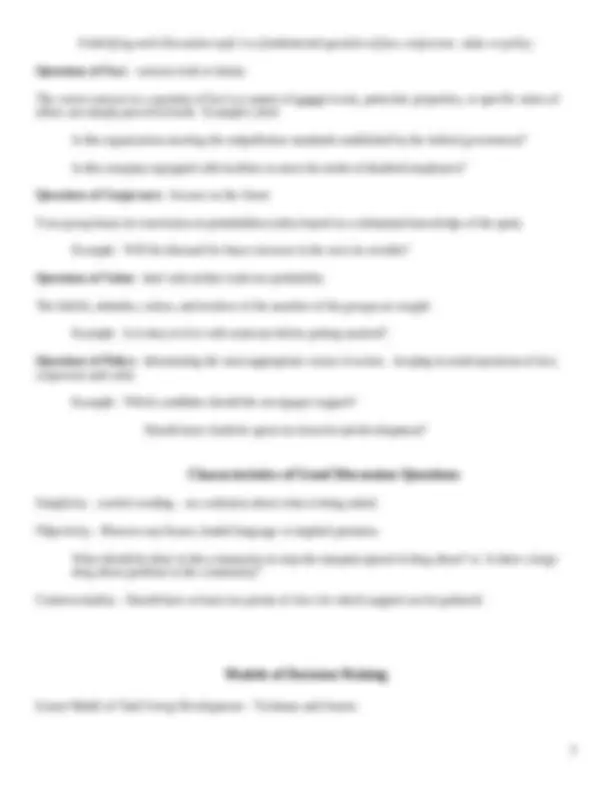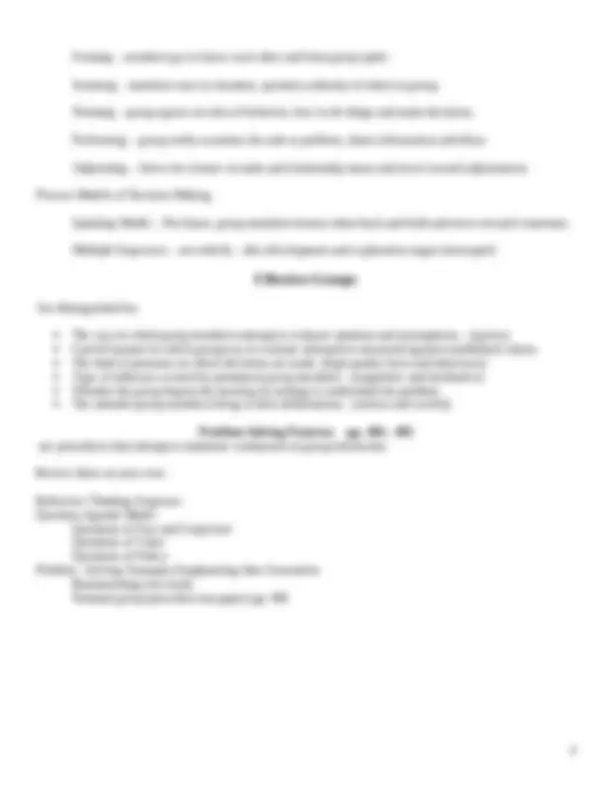




Study with the several resources on Docsity

Earn points by helping other students or get them with a premium plan


Prepare for your exams
Study with the several resources on Docsity

Earn points to download
Earn points by helping other students or get them with a premium plan
Community
Ask the community for help and clear up your study doubts
Discover the best universities in your country according to Docsity users
Free resources
Download our free guides on studying techniques, anxiety management strategies, and thesis advice from Docsity tutors
Chapter 11 notes Material Type: Notes; Professor: Smith; Class: Business and Professional Communications; Subject: Speech Communication; University: Ithaca College; Term: Fall 2011;
Typology: Study notes
1 / 4

This page cannot be seen from the preview
Don't miss anything!



Pros and Cons of group work: Cons Groups take time Many people lack training in group discussion skills Some leaders do not really allow groups to make decisions Other leaders listen and then go off and make the decision alone Pros Generation of more ideas and better quality decisions than when working alone Can stimulate creativity More information and knowledge than just one person Greater diversity of perspectives Members of the group making decision understand how and why decisions were made – increasing commitment to decisions and improves morale Most of us feel more useful, productive, and more valued as professionals when we have a chance to share in making significant decisions Those who are skilled in group decision-making are much more likely to rise both in the esteem of their peers and superiors and in the organizational hierarchy. It is impossible to choose a particular procedure to be followed in all decision-making groups because the dynamics of groups change or are different. It is better to be aware of: Group variables Knowing how to best prepare for group meetings How groups change over time So that you can adapt appropriately to each new group context.
Preparing for Group Participation You will work in decision-making groups for three basic reasons: Acquire some by joining a company such as: Department or unit meetings Company wide meetings Employee training sessions You will be assigned other group memberships United Way representative Task force representing your department You will be appointed to groups whose membership you seek Quality circles YOUR INITIAL RESPONSIBILITY TO ANY OF THESE GROUPS IS TO PREPARE CAREFULLY First - prepare by taking a personal inventory of: Ideas, information, and other relevant data already in your possession. Your existing attitudes, opinions and knowledge Then identify your information gaps and – Do a research process as if you were doing a speech on a problem or issue to be discussed and determine the quality of the information gathered. o Collect info. from multiple sources Interviews Library research Internet o Assess it for its – Accuracy Recency Completeness Source reliability Approach your research with a spirit of open-mindedness and desire to be as knowledgeable as possible prior to the group meeting. Also, have the desire to share decision making with fellow group members. Discussion Questions
Forming – members get to know each other and form group spirit Storming – members react to situation, question authority of others in group. Norming – group agrees on rules of behavior, how to do things and make decisions. Performing – group really examines the task or problem, shares information and ideas. Adjourning – Strive for closure on tasks and relationship issues and move toward adjournment. Process Models of Decision Making Spiraling Model – Not linear, group members bounce ideas back and forth and move toward consensus. Multiple Sequences – not orderly – idea development and exploration stages interrupted
Are distinguished by: The way in which group members attempt to evaluate opinions and assumptions – rigorous Careful manner in which groups try to evaluate alternatives measured against established criteria The kind of premises on which decisions are made. (high-quality facts and inferences) Type of influence exerted by prominent group members. (supportive and facilitative) Whether the group begins the meeting by seeking to understand the problem. The attitudes group members bring to their deliberations. (serious and careful) Problem-Solving Patterns: pp. 404 - 405 are procedures that attempt to minimize weaknesses in group interaction Review them on your own: Reflective Thinking Sequence Question-Agenda Model Questions of Fact and Conjecture Questions of Value Questions of Policy Problem –Solving Strategies Emphasizing Idea Generation Brainstorming (out loud) Nominal group procedure (on paper) pp. 406